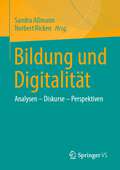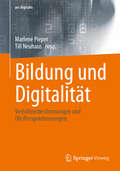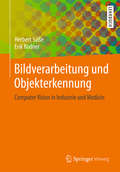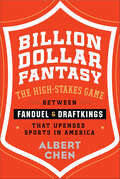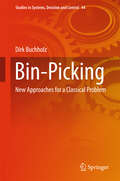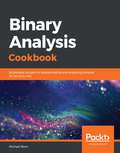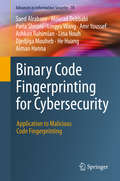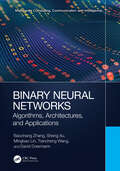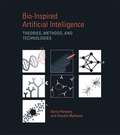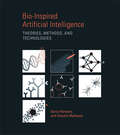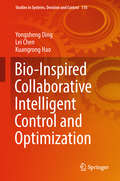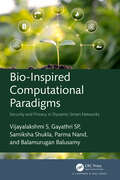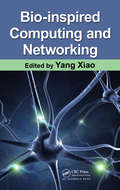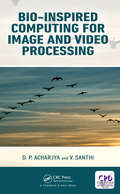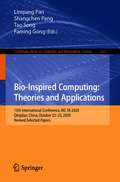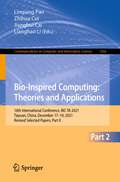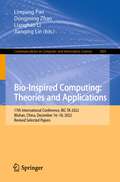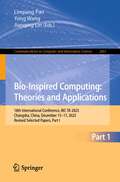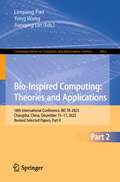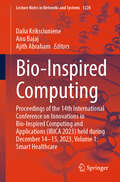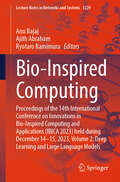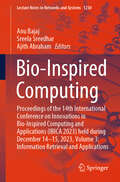- Table View
- List View
Bildung und Digitalität: Analysen – Diskurse – Perspektiven
by Norbert Ricken Sandra AßmannMit ›Bildung‹ und ›Digitalität‹ wird ein intensiv diskutiertes Spannungsfeld markiert: Einerseits wird oft die ›digitale Rückständigkeit‹ von Schule beklagt, andererseits aber lassen sich auch pädagogische Skepsis und Hemmnisse nicht einfach übersehen. An dieser Spannung setzen die Beiträge des Bandes an und fragen sowohl nach den Herausforderungen der ›Bildung‹ durch ›Digitalität‹ als auch umgekehrt nach den Anforderungen an ›Digitalität› durch ›Bildung‹. Das macht aber nötig, ›Digitalisierung‹ nicht bloß als (gar technische) Anwendungsproblematik und didaktische Herausforderung aufzunehmen, sondern auch (grundlagen-)theoretisch zu reflektieren. Dabei werden entlang der Fragen nach den jeweiligen Medien-, Subjekt- und Wissensformationen des ›Digitalen‹ auch Konturen eines pädagogischen Strukturwandels erkennbar und diskutierbar.
Bildung und Digitalität: Verhältnisbestimmungen und (Re)Perspektivierungen (ars digitalis)
by Till Neuhaus Marlene PieperBildung und Digitalität bilden einen Zusammenhang, der in seiner Dringlichkeit an unzähligen wissenschaftlichen, institutionellen und gesellschaftlichen Stellschrauben diskutiert und gestaltet wird. Der überwältigende Großteil der Diskurse, Abhandlungen und Visionen gruppieren sich um das Schlagwort der „Digitalität“, welches in seiner Wirkmacht auf sämtliche Lebensbereiche als entscheidende neue Rahmenbedingung für bildungsbezogene Entwicklungen anerkannt wird. „Bildung“ als Konzept rückt indes nicht in der gleichen Komplexität in den Fokus; die Dimension des Bildungsbegriffs bleibt unterbetont. Findet das Nachdenken über Bildung und Digitalität gar in Isolation vom Bildungsbegriff und seinen Verankerungen statt? Wird in den mannigfaltigen Konfigurationen einer „digitalen Bildung“ überhaupt deutlich, was Bildung will und sein kann? Diese Schlagseite muss überraschen, zeichnet sich der Begriff „Bildung“ als „God-Term“ der Pädagogik doch durch seinen historisch wie theoretisch reichhaltigen Unterbau sowie seine kulturelle Verankerung im deutschsprachigen Raum aus. Dieser Band nimmt sich diesen eklatanten Leerstellen und Verkürzungen im Diskurs um Digitalität an, indem er die Komplexität des Bildungsbegriffs für sein Publikum aufschlüsselt und für drängende Fragestellungen zum Lehren und Lernen in einer digitalisierten Welt nutzbar macht. Der Band geht davon aus, dass viele prävalente Fragenkomplexe aus dem Bereich der Digitalität bereits anteilig im Bildungsbegriff diskutiert worden sind, sodass ein Zusammendenken auf Augenhöhe richtungweisend ist.
Bildungsautomaten?: Beiträge zur Digitalisierung von Bildung und Lehre (ars digitalis)
by Florian Fuchs Tim RaupachDer vorliegende Band versteht sich als interdisziplinäre Intervention in die aktuellen Debatten um die “Kultur der Digitalität” (Stalder) bzw. den Digitalisierungsprozess in Lehre und Unterricht. Die mit der Corona-Pandemie forcierte Digitalisierung von universitärer Lehre und Schulunterricht wird auf die ihr zugrundeliegende positivistisch-behavioristische Machbarkeitsideologie untersucht und somit als Teil eines neuen Herrschaftstypus sichtbar gemacht.
Bildverarbeitung und Objekterkennung: Computer Vision in Industrie und Medizin
by Herbert Süße Erik RodnerDieses Buch erläutert, wie Informationen automatisch aus Bildern extrahiert werden. Mit dieser sehr aktuellen Frage beschäftigt sich das Buch mittels eines Streifzuges durch die Bildverarbeitung. Dabei werden sowohl die mathematischen Grundlagen vieler Verfahren der 2D- und 3D-Bildanalyse vermittelt als auch deren Nutzen anhand von Problemstellungen aus vielen Bereichen (Medizin, industrielle Bildverarbeitung, Objekterkennung) erläutert. Das Buch eignet sich sowohl für Studierende der Informatik, Mathematik und Ingenieurwissenschaften als auch für Anwender aus der industriellen Bildverarbeitung.
Billion Dollar Fantasy: The High-Stakes Game Between FanDuel and DraftKings that Upended Sports in America
by Albert ChenBillion Dollar Fantasy has descriptive copy which is not yet available from the Publisher.
Billionaire on the Loose: Billionaires and Bridesmaids 5 (Billionaires and Bridesmaids #5)
by Jessica ClareEnter the illustrious world of Jessica Clare's billionaires and bridesmaids. Fans of J.S. Scott, Louise Bay and Melody Anne will addicted to this sizzling, coveted New York Times bestseller. You met the six bachelors of the Billionaire Boys Club... Now it's time to pair up some filthy-rich billionaires with lucky ladies in waiting and enjoy the spoils... Taylor is a genius when it comes to computers, but understanding the opposite sex is beyond her. Because she always fumbles her flirtations, she needs help in finding her Prince Charming. So when her friend, Gretchen, sets her up as a tour guide for a new guy in town, she says yes despite her misgivings.She just doesn't expect Mr. Charming to actually be royalty...A faction in his country wants him to be king, but Loch has no intention of taking the crown. To keep from being named as the next successor, he hatches a scheme to marry a totally unacceptable American woman. Quirky Taylor seems like the perfect person for the job, until Loch realizes he likes more about her than her ability to keep him off the throne.When Loch's secret schemes come out, his chance of happiness with Taylor are blown - unless he can find a way to get the nerdy object of his affection to believe she's truly the queen of his heart... Includes a teaser for The Billionaire's Favourite Mistake!After more dazzling romance? Look out for the rest of the Billionaire and Bridesmaids series starting with The Billionaire And The Virgin or take a spin with the steamy Billionaire Boys Club starting with Stranded With A Billionaire.
Bin-Picking: New Approaches for a Classical Problem (Studies in Systems, Decision and Control #44)
by Dirk BuchholzThis bookis devoted to one of the most famous examples of automation handling tasks -the "bin-picking" problem. To pick up objects, scrambled in a box is aneasy task for humans, but its automation is very complex. In this book threedifferent approaches to solve the bin-picking problem are described, showinghow modern sensors can be used for efficient bin-picking as well as how classicsensor concepts can be applied for novel bin-picking techniques. 3D pointclouds are firstly used as basis, employing the known Random Sample Matchingalgorithm paired with a very efficient depth map based collision avoidancemechanism resulting in a very robust bin-picking approach. Reducing thecomplexity of the sensor data, all computations are then done on depth maps. This allows the use of 2D image analysis techniques to fulfill the tasks andresults in real time data analysis. Combined with force/torque and accelerationsensors, a near time optimal bin-picking system emerges. Lastly, surface normalmaps are employed as a basis for pose estimation. In contrast to knownapproaches, the normal maps are not used for 3D data computation but directlyfor the object localization problem, enabling the application of a new class ofsensors for bin-picking.
Binary Analysis Cookbook: Actionable recipes for disassembling and analyzing binaries for security risks
by Michael BornExplore open-source Linux tools and advanced binary analysis techniques to analyze malware, identify vulnerabilities in code, and mitigate information security risks Key Features Adopt a methodological approach to binary ELF analysis on Linux Learn how to disassemble binaries and understand disassembled code Discover how and when to patch a malicious binary during analysis Book Description Binary analysis is the process of examining a binary program to determine information security actions. It is a complex, constantly evolving, and challenging topic that crosses over into several domains of information technology and security. This binary analysis book is designed to help you get started with the basics, before gradually advancing to challenging topics. Using a recipe-based approach, this book guides you through building a lab of virtual machines and installing tools to analyze binaries effectively. You'll begin by learning about the IA32 and ELF32 as well as IA64 and ELF64 specifications. The book will then guide you in developing a methodology and exploring a variety of tools for Linux binary analysis. As you advance, you'll learn how to analyze malicious 32-bit and 64-bit binaries and identify vulnerabilities. You'll even examine obfuscation and anti-analysis techniques, analyze polymorphed malicious binaries, and get a high-level overview of dynamic taint analysis and binary instrumentation concepts. By the end of the book, you'll have gained comprehensive insights into binary analysis concepts and have developed the foundational skills to confidently delve into the realm of binary analysis. What you will learn Traverse the IA32, IA64, and ELF specifications Explore Linux tools to disassemble ELF binaries Identify vulnerabilities in 32-bit and 64-bit binaries Discover actionable solutions to overcome the limitations in analyzing ELF binaries Interpret the output of Linux tools to identify security risks in binaries Understand how dynamic taint analysis works Who this book is for This book is for anyone looking to learn how to dissect ELF binaries using open-source tools available in Linux. If you're a Linux system administrator or information security professional, you'll find this guide useful. Basic knowledge of Linux, familiarity with virtualization technologies and the working of network sockets, and experience in basic Python or Bash scripting will assist you with understanding the concepts in this book
Binary Code Fingerprinting for Cybersecurity: Application to Malicious Code Fingerprinting (Advances in Information Security #78)
by He Huang Lingyu Wang Mourad Debbabi Amr Youssef Djedjiga Mouheb Saed Alrabaee Paria Shirani Ashkan Rahimian Lina Nouh Aiman HannaThis book addresses automated software fingerprinting in binary code, especially for cybersecurity applications. The reader will gain a thorough understanding of binary code analysis and several software fingerprinting techniques for cybersecurity applications, such as malware detection, vulnerability analysis, and digital forensics. More specifically, it starts with an overview of binary code analysis and its challenges, and then discusses the existing state-of-the-art approaches and their cybersecurity applications. Furthermore, it discusses and details a set of practical techniques for compiler provenance extraction, library function identification, function fingerprinting, code reuse detection, free open-source software identification, vulnerability search, and authorship attribution. It also illustrates several case studies to demonstrate the efficiency, scalability and accuracy of the above-mentioned proposed techniques and tools. This book also introduces several innovative quantitative and qualitative techniques that synergistically leverage machine learning, program analysis, and software engineering methods to solve binary code fingerprinting problems, which are highly relevant to cybersecurity and digital forensics applications. The above-mentioned techniques are cautiously designed to gain satisfactory levels of efficiency and accuracy. Researchers working in academia, industry and governmental agencies focusing on Cybersecurity will want to purchase this book. Software engineers and advanced-level students studying computer science, computer engineering and software engineering will also want to purchase this book.
Binary Neural Networks: Algorithms, Architectures, and Applications (Multimedia Computing, Communication and Intelligence)
by David Doermann Sheng Xu Baochang Zhang Mingbao Lin Tiancheng WangDeep learning has achieved impressive results in image classification, computer vision, and natural language processing. To achieve better performance, deeper and wider networks have been designed, which increase the demand for computational resources. The number of floatingpoint operations (FLOPs) has increased dramatically with larger networks, and this has become an obstacle for convolutional neural networks (CNNs) being developed for mobile and embedded devices. In this context, Binary Neural Networks: Algorithms, Architectures, and Applications will focus on CNN compression and acceleration, which are important for the research community. We will describe numerous methods, including parameter quantization, network pruning, low-rank decomposition, and knowledge distillation. More recently, to reduce the burden of handcrafted architecture design, neural architecture search (NAS) has been used to automatically build neural networks by searching over a vast architecture space. Our book will also introduce NAS and binary NAS and its superiority and state-of-the-art performance in various applications, such as image classification and object detection. We also describe extensive applications of compressed deep models on image classification, speech recognition, object detection, and tracking. These topics can help researchers better understand the usefulness and the potential of network compression on practical applications. Moreover, interested readers should have basic knowledge of machine learning and deep learning to better understand the methods described in this book. Key Features • Reviews recent advances in CNN compression and acceleration • Elaborates recent advances on binary neural network (BNN) technologies • Introduces applications of BNN in image classification, speech recognition, object detection, and more Baochang Zhang is a full professor with the Institute of Artificial Intelligence, Beihang University, Beijing, China. He was selected by the Program for New Century Excellent Talents in the University of Ministry of Education of China, chosen as the Academic Advisor of the Deep Learning Lab of Baidu Inc., and was honored as a Distinguished Researcher of Beihang Hangzhou Institute in Zhejiang Province. His research interests include explainable deep learning, computer vision, and pattern recognition. His HGPP and LDP methods were state-of-the-art feature descriptors, with 1234 and 768 Google Scholar citations, respectively, and both “Test-of-Time” works. His team’s 1-bit methods achieved the best performance on ImageNet. His group also won the ECCV 2020 Tiny Object Detection, COCO Object Detection, and ICPR 2020 Pollen recognition challenges. Sheng Xu received a BE in automotive engineering from Beihang University, Beijing, China. He has a PhD and is currently at the School of Automation Science and Electrical Engineering, Beihang University, specializing in computer vision, model quantization, and compression. He has made significant contributions to the field and has published about a dozen papers as the first author in top-tier conferences and journals such as CVPR, ECCV, NeurIPS, AAAI, BMVC, IJCV, and ACM TOMM. Notably, he has 4 papers selected as oral or highlighted presentations by these prestigious conferences. Furthermore, Dr. Xu actively participates in the academic community as a reviewer for various international journals and conferences, including CVPR, ICCV, ECCV, NeurIPS, ICML, and IEEE TCSVT. His expertise has also led to his group’s victory in the ECCV 2020 Tiny Object Detection Challenge. Mingbao Lin finished his MS-PhD study and obtained a PhD in intelligence science and technology from Xiamen University, Xiamen, China in 2022. In 2016, he received a BS from Fuzhou University, Fuzhou, China. He is currently a senior researcher with the Tencent Youtu Lab, Shanghai, China. His publications on top-tier conferences/journals include: IEEE TP
Binary Representation Learning on Visual Images: Learning to Hash for Similarity Search
by Zheng ZhangThis book introduces pioneering developments in binary representation learning on visual images, a state-of-the-art data transformation methodology within the fields of machine learning and multimedia. Binary representation learning, often known as learning to hash or hashing, excels in converting high-dimensional data into compact binary codes meanwhile preserving the semantic attributes and maintaining the similarity measurements. The book provides a comprehensive introduction to the latest research in hashing-based visual image retrieval, with a focus on binary representations. These representations are crucial in enabling fast and reliable feature extraction and similarity assessments on large-scale data. This book offers an insightful analysis of various research methodologies in binary representation learning for visual images, ranging from basis shallow hashing, advanced high-order similarity-preserving hashing, deep hashing, as well as adversarial and robust deep hashing techniques. These approaches can empower readers to proficiently grasp the fundamental principles of the traditional and state-of-the-art methods in binary representations, modeling, and learning. The theories and methodologies of binary representation learning expounded in this book will be beneficial to readers from diverse domains such as machine learning, multimedia, social network analysis, web search, information retrieval, data mining, and others.
Bio-Inspired Artificial Intelligence: Theories, Methods, and Technologies
by Dario Floreano Claudio MattiussiNew approaches to artificial intelligence spring from the idea that intelligence emerges as much from cells, bodies, and societies as it does from evolution, development, and learning. Traditionally, artificial intelligence has been concerned with reproducing the abilities of human brains; newer approaches take inspiration from a wider range of biological structures that that are capable of autonomous self-organization. Examples of these new approaches include evolutionary computation and evolutionary electronics, artificial neural networks, immune systems, biorobotics, and swarm intelligence--to mention only a few. This book offers a comprehensive introduction to the emerging field of biologically inspired artificial intelligence that can be used as an upper-level text or as a reference for researchers. Each chapter presents computational approaches inspired by a different biological system; each begins with background information about the biological system and then proceeds to develop computational models that make use of biological concepts. The chapters cover evolutionary computation and electronics; cellular systems; neural systems, including neuromorphic engineering; developmental systems; immune systems; behavioral systems--including several approaches to robotics, including behavior-based, bio-mimetic, epigenetic, and evolutionary robots; and collective systems, including swarm robotics as well as cooperative and competitive co-evolving systems. Chapters end with a concluding overview and suggested reading.
Bio-Inspired Artificial Intelligence: Theories, Methods, and Technologies (Intelligent Robotics and Autonomous Agents)
by Dario Floreano Claudio MattiussiA comprehensive introduction to new approaches in artificial intelligence and robotics that are inspired by self-organizing biological processes and structures. New approaches to artificial intelligence spring from the idea that intelligence emerges as much from cells, bodies, and societies as it does from evolution, development, and learning. Traditionally, artificial intelligence has been concerned with reproducing the abilities of human brains; newer approaches take inspiration from a wider range of biological structures that that are capable of autonomous self-organization. Examples of these new approaches include evolutionary computation and evolutionary electronics, artificial neural networks, immune systems, biorobotics, and swarm intelligence—to mention only a few. This book offers a comprehensive introduction to the emerging field of biologically inspired artificial intelligence that can be used as an upper-level text or as a reference for researchers. Each chapter presents computational approaches inspired by a different biological system; each begins with background information about the biological system and then proceeds to develop computational models that make use of biological concepts. The chapters cover evolutionary computation and electronics; cellular systems; neural systems, including neuromorphic engineering; developmental systems; immune systems; behavioral systems—including several approaches to robotics, including behavior-based, bio-mimetic, epigenetic, and evolutionary robots; and collective systems, including swarm robotics as well as cooperative and competitive co-evolving systems. Chapters end with a concluding overview and suggested reading.
Bio-Inspired Collaborative Intelligent Control and Optimization (Studies in Systems, Decision and Control #118)
by Lei Chen Yongsheng Ding Kuangrong HaoThis book presents state-of-the-art research advances in the field of biologically inspired cooperative control theories and their applications. It describes various biologically inspired cooperative control and optimization approaches and highlights real-world examples in complex industrial processes. Multidisciplinary in nature and closely integrating theory and practice, the book will be of interest to all university researchers, control engineers and graduate students in intelligent systems and control who wish to learn the core principles, methods, algorithms, and applications.
Bio-Inspired Computational Paradigms: Security and Privacy in Dynamic Smart Networks
by Samiksha Shukla Parma Nand Vijayalakshmi S Gayathri SpSmart cities with various technological innovations have played an important role and influenced society as well. Due to voluminous data transactions within smart cities, security and privacy concerns need to be dealt with. Though taking care of safety and privacy is challenging, it is essential for a smart city to understand the bio-inspired computing paradigms. This book discusses the utilization of bio-inspired computing procedures for effective computational devices.• Discusses real-world usage of bio-inspired computations• Highlights how bio-inspired computations hold the potential to significantly increase network security and privacy• Talks about how society can avoid consequences of cyber security breaches• Examines the combination of bio-inspired computational methods with IoT, AI and big dataThis book is primarily aimed at graduates, researchers, IT and industry professionals.
Bio-Inspired Computing and Networking
by Yang XiaoSeeking new methods to satisfy increasing communication demands, researchers continue to find inspiration from the complex systems found in nature. From ant-inspired allocation to a swarm algorithm derived from honeybees, Bio-Inspired Computing and Networking explains how the study of biological systems can significantly improve computing, networki
Bio-Inspired Computing for Image and Video Processing
by V. Santhi D. P. AcharjyaIn recent years bio-inspired computational theories and tools have developed to assist people in extracting knowledge from high dimensional data. These differ in how they take a more evolutionary approach to learning, as opposed to traditional artificial intelligence (AI) and what could be described as 'creationist' methods. Instead bio-inspired computing takes a bottom-up, de-centralized approach that often involves the method of specifying a set of simple rules, a set of simple organisms which adhere to those rules, and of iteratively applying those rules. Bio-Inspired Computing for Image and Video Processing covers interesting and challenging new theories in image and video processing. It addresses the growing demand for image and video processing in diverse application areas, such as secured biomedical imaging, biometrics, remote sensing, texture understanding, pattern recognition, content-based image retrieval, and more. This book is perfect for students following this topic at both undergraduate and postgraduate level. It will also prove indispensable to researchers who have an interest in image processing using bio-inspired computing.
Bio-Inspired Computing: 15th International Conference, BIC-TA 2020, Qingdao, China, October 23-25, 2020, Revised Selected Papers (Communications in Computer and Information Science #1363)
by Linqiang Pan Tao Song Shangchen Pang Faming GongThis volume constitutes the revised selected papers of the 15th International Conference on Bio-inspired Computing: Theories and Applications, BIC-TA 2020, held in Qingdao, China, in October 2020.The 43 full papers presented in both volumes were selected from 109 submissions. The papers are organized according to the topical headings: evolutionary computation and swarm intelligence; neural networks and machine learning; DNA computing and membrane computing.
Bio-Inspired Computing: 16th International Conference, BIC-TA 2021, Taiyuan, China, December 17–19, 2021, Revised Selected Papers, Part II (Communications in Computer and Information Science #1566)
by Linqiang Pan Zhihua Cui Jianghui Cai Lianghao LiThis two-volume set (CCIS 1565 and CCIS 1566) constitutes selected and revised papers from the 16th International Conference on Bio-Inspired Computing: Theories and Applications, BIC-TA 2021, held in Taiyuan, China, in December 2021. The 67 papers presented were thoroughly reviewed and selected from 211 submissions. The papers are organized in the following topical sections: evolutionary computation and swarm intelligence; DNA and molecular computing; machine learning and computer vision.
Bio-Inspired Computing: 17th International Conference, BIC-TA 2022, Wuhan, China, December 16–18, 2022, Revised Selected Papers (Communications in Computer and Information Science #1801)
by Linqiang Pan Lianghao Li Dongming Zhao Jianqing LinThis book constitutes the refereed proceedings of the 17th International Conference on Bio-Inspired Computing: Theories and Applications, BIC-TA 2022, held in Wuhan, China, during December 16–18, 2022.The 56 full papers included in this book were carefully reviewed and selected from 148 submissions. They were organized in topical sections as follows: evolutionary computation and swarm intelligence; machine learning and deep learning; intelligent control and simulation and molecular computing and nanotechnology.
Bio-Inspired Computing: 18th International Conference, BIC-TA 2023, Changsha, China, December 15–17, 2023, Revised Selected Papers, Part I (Communications in Computer and Information Science #2061)
by Yong Wang Linqiang Pan Jianqing LinThe two-volume set CCIS 2061 and 2062 constitutes the refereed post-conference proceedings of the 18th International Conference on Bio-Inspired Computing: Theories and Applications, BIC-TA 2023, held in Changsha, China, during December 15–17, 2023.The 64 revised full papers presented in these proceedings were carefully reviewed and selected from 168 submissions. The papers are organized in the following topical sections: Volume I: Evolutionary Computation and Swarm Intelligence; and Membrane Computing and DNA ComputingVolume II: Machine Learning and Applications; and Intelligent Control and Application.
Bio-Inspired Computing: 18th International Conference, BIC-TA 2023, Changsha, China, December 15–17, 2023, Revised Selected Papers, Part II (Communications in Computer and Information Science #2062)
by Yong Wang Linqiang Pan Jianqing LinThe two-volume set CCIS 2061 and 2062 constitutes the refereed post-conference proceedings of the 18th International Conference on Bio-Inspired Computing: Theories and Applications, BIC-TA 2023, held in Changsha, China, during December 15–17, 2023.The 64 revised full papers presented in these proceedings were carefully reviewed and selected from 168 submissions. The papers are organized in the following topical sections: Volume I: Evolutionary Computation and Swarm Intelligence; and Membrane Computing and DNA ComputingVolume II: Machine Learning and Applications; and Intelligent Control and Application.
Bio-Inspired Computing: Proceedings of the 14th International Conference on Innovations in Bio-Inspired Computing and Applications (IBICA 2023) held during December 14-15, 2023, Volume 1: Smart Healthcare (Lecture Notes in Networks and Systems #1228)
by Ajith Abraham Dalia Kriksciuniene Anu BajajThis book presents 53 selected papers focused on Smart Health Care from the 14th International Conference on Innovations in Bio-Inspired Computing and Applications (IBICA 2023) and 13th World Congress on Information and Communication Technologies (WICT 2023), which was held in five different cities namely Olten, Switzerland; Porto, Portugal; Kaunas, Lithuania; Greater Noida, India; Kochi, India and in online mode. The 23rd International Conference on Hybrid Intelligent Systems (IBICA-WICT 2023) was focusing on synergistic combinations of multiple approaches to develop the next generation of bio-inspired computing and ICT systems. IBICA-WICT 2023 had contributions by authors from 36 countries. This book offers a valuable reference guide for all medical doctors, scientists, academicians, researchers, students, and practitioners in the field of artificial intelligence and smart health care.
Bio-Inspired Computing: Proceedings of the 14th International Conference on Innovations in Bio-Inspired Computing and Applications (IBICA 2023) held during December 14-15, 2023, Volume 2: Deep Learning and Large Language Models (Lecture Notes in Networks and Systems #1229)
by Ajith Abraham Anu Bajaj Ryotaro KamimuraThis book presents 53 selected papers focused on Deep Learning and Large Language Models from the 14th International Conference on Innovations in Bio-Inspired Computing and Applications (IBICA 2023) and 13th World Congress on Information and Communication Technologies (WICT 2023), which was held in five different cities namely Olten, Switzerland; Porto, Portugal; Kaunas, Lithuania; Greater Noida, India; Kochi, India and in online mode. The 23rd International Conference on Hybrid Intelligent Systems (IBICA-WICT 2023) was focusing on synergistic combinations of multiple approaches to develop the next generation of bio-inspired computing and ICT systems. IBICA-WICT 2023 had contributions by authors from 36 countries. This book offers a valuable reference guide for all scientists, academicians, researchers, students, and practitioners focused on advanced machine learning including deep learning methods, large language models, and its real-world applications.
Bio-Inspired Computing: Proceedings of the 14th International Conference on Innovations in Bio-Inspired Computing and Applications (IBICA 2023) held during December 14-15, 2023, Volume 3: Information Retrieval and Applications (Lecture Notes in Networks and Systems #1230)
by Ajith Abraham Anu Bajaj Sreela SreedharThis book presents 51 selected papers focused on Information Retrieval and Applications from the 14th International Conference on Innovations in Bio-Inspired Computing and Applications (IBICA 2023) and 13th World Congress on Information and Communication Technologies (WICT 2023), which was held in five different cities namely Olten, Switzerland; Porto, Portugal; Kaunas, Lithuania; Greater Noida, India; Kochi, India and in online mode. IBICA-WICT 2023 had contributions by authors from 36 countries. This book offers a valuable reference guide for all scientists, academicians, researchers, students, and practitioners focused on Information Retrieval and Applications.
